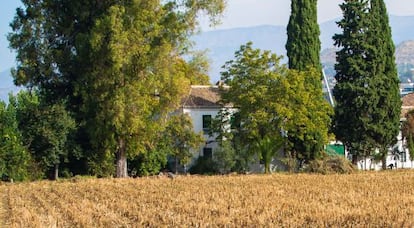Granada moves to protect seven key Lorca sites
Work also restarted on center devoted to distinguished poet

Granada has taken several steps forward in reconciling itself with its most distinguished, if still somewhat neglected, literary son, Federico García Lorca.
After a two-year stoppage, on October 21 work was restarted on the García Lorca Center, a building that hopes to be for Granada what the Picasso Museum is to Málaga.
A week before, the house of Frasquita Alba in Valderrubio - which served as the inspiration for Lorca's great play The House of Bernarda Alba - passed into the hands of a public institution, which plans to restore the building and turn it into a museum.
What's more, in the last few days the Andalusian regional government's committee for culture has approved the order to declare this latter property and six other places that were important in Lorca's life sites of cultural interest (BIC).
The passing of the Frasquita Alba house into public hands comes after almost a decade of negotiations with the Alba family, who lived in the property until 1997. Its new owner is the Vega-Sierra Elvira Consortium, which is funded by 26 city municipalities and has a budget of 177,000 euros.
The other spaces - which the regional administration's culture delegate in Granada, Ana Gámez, says will receive their protection as historical sites in "around six months" - include the Lorca family house in Valderrubio, where the future poet lived from 1905 to 1909 when his family moved into Granada. "But he came back every summer until 1925, maintaining contact with the meadow," says José Castillo, a lecturer in art history at the University of Granada whom the culture department entrusted with the historical and technical research needed to compile the documents for granting the sites BIC status.
Also on the list are the Federico García Lorca House Museum in Fuente Vaqueros, where the poet was born, as well as the Huerta de San Vicente in Granada, where the Lorcas spent their summers between 1926 and 1936.
The other three BIC spaces are less well known: the Huerta del Tamarit, close to Huerta de San Vicente, was a farm bought by Lorca's uncle, Francisco García Rodríguez, that inspired the poet to write the Diván del Tamarit, a homage to Granada's Arab poets.
The sixth spot, la Fuente de la Teja in Valderrubio, is "a spot on the banks of the River Cubillas, much frequented by Lorca during the summers of his childhood [...] and cited in several works by the poet," explains Castillo.
The final location is Colonias de Viznar, the site of the farmhouse where Lorca was held in the hours before he was shot by Nationalist forces during the Civil War in 1936.
Tu suscripción se está usando en otro dispositivo
¿Quieres añadir otro usuario a tu suscripción?
Si continúas leyendo en este dispositivo, no se podrá leer en el otro.
FlechaTu suscripción se está usando en otro dispositivo y solo puedes acceder a EL PAÍS desde un dispositivo a la vez.
Si quieres compartir tu cuenta, cambia tu suscripción a la modalidad Premium, así podrás añadir otro usuario. Cada uno accederá con su propia cuenta de email, lo que os permitirá personalizar vuestra experiencia en EL PAÍS.
¿Tienes una suscripción de empresa? Accede aquí para contratar más cuentas.
En el caso de no saber quién está usando tu cuenta, te recomendamos cambiar tu contraseña aquí.
Si decides continuar compartiendo tu cuenta, este mensaje se mostrará en tu dispositivo y en el de la otra persona que está usando tu cuenta de forma indefinida, afectando a tu experiencia de lectura. Puedes consultar aquí los términos y condiciones de la suscripción digital.
Últimas noticias
Reinhard Genzel, Nobel laureate in physics: ‘One-minute videos will never give you the truth’
Pinochet’s victims grapple with José Antonio Kast’s rise in Chile
How Japan is trying to avert ‘digital defeat’
The complicated life of Francesca Albanese: A rising figure in Italy but barred from every bank by Trump’s sanctions
Most viewed
- Pablo Escobar’s hippos: A serious environmental problem, 40 years on
- Why we lost the habit of sleeping in two segments and how that changed our sense of time
- Charles Dubouloz, mountaineering star, retires at 36 with a farewell tour inspired by Walter Bonatti
- Trump’s obsession with putting his name on everything is unprecedented in the United States
- The Florida Keys tourist paradise is besieged by immigration agents: ‘We’ve never seen anything like this’








































